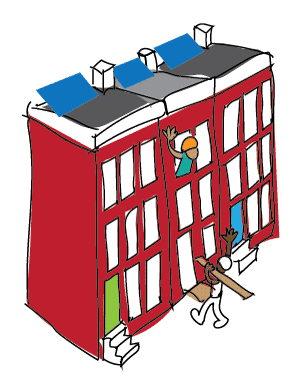
2) Rehabbing Neighborhood Houses
A school for business needs a business to run. The business would be rehabbing housing in the neighborhood.
I've discussed this with Habitat for Humanity, and they are definitely willing to partner with this project. The cost of rehabbing a house is approximately the same cost as building a house, about $70,000 each. (If partnered with Habitat, they could provide the financing, eliminating our section #3, Building & Loan.)
It's possible this work could contribute to a model for the efficient rehabbing of buildings, including demolition, lead abatement, roofs, floors, walls, windows, electrical and plumbing. Rehabbed houses could include solar energy and other modern green technology, which the students would help install, increasing the students' value on the job market.
Tiny houses or shipping crate houses
If the city is willing to tear down sufficient old buildings, and students were being taught a construction curriculum instead of an industrial design curriculum, and the school was located in an old factory, instead of rehabbing old homes the students could build tiny homes ($20-$30,000) or homes made out of shipping crates ($30-$40,000) on the factory floor.
Either way, houses are return to tax roll and lived in by owners, not renters.
Habitat for Humanity
Addendum: As mentioned above, I discussed this project briefly with Matt Metzger, Director of Volunteer Engagement for Habitat for Humanity/Chesapeake on August 20, 2015 and again on May 31, 2017. He said:
- It may be possible to work with Habitat for Humanity on this project.
- The cost of rehabbing a house is about $100,000-$150,000 to gut it, do lead abatement, and make it energy-star compliant, so to be affordable there would have to be donations, grants, etc. involved, which would further encourage the school working with Habitat.
- Habitat has worked with other schools on work training before, and are currently running construction classes.
- Houses generally take 4-9 mos. to rehab, and require a combination of low-skilled and high-skilled labor.
- The drawback in the past has been student transportation to rehab sites, so we'll either need a small bus or be walking distance to a current Habitat project.
- Habitat may be interested in having students intern with their ReStore stores, which would give them a broad exposure to business practices.